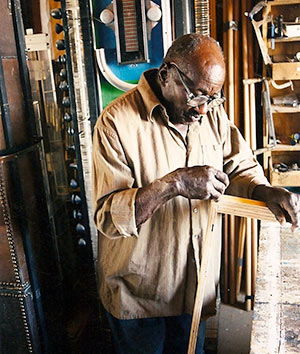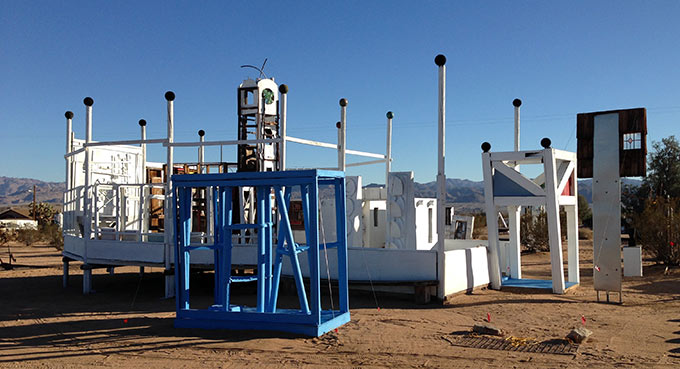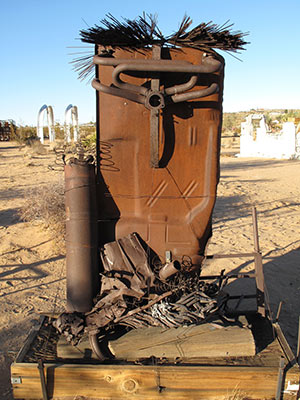Photo Images Noah Purifoy Outdoor Art Museum Joshua Tree Ca
"I promise my work provides inspiration for a person to do today what they couldn't do yesterday, no matter what it is. That's fine art ... That'southward the key artistic process and it'due south something that changes people and empowers them. "
– Noah Purifoy, 2000
History
The Noah Purifoy Outdoor Desert Art Museum of Assemblage Sculpture sits on ten-acres in the Mojave Desert foothills near the Mojave National Preserve, an austere expanse of scrubby desert and jagged mountains established in 1994 as part of the California Desert Protection Human activity. The site holds the home, studio, and sculpture park of renowned aggregation artist Noah Purifoy (1917-2004) who lived in that location from 1989 until his death.

Noah Purifoy working in his studio, photo by Sue A. Welsh
Purifoy starting time gained acclaim for his participation in the 1966 traveling group exhibition 66 Signs of Neon, which he organized with fellow artist Judson Powell. The groundbreaking evidence with work by 8 artists was organized in response to the August 1965 racial riots in Los Angeles' Watts neighborhood. Purifoy, a cofounder and first director of the metropolis'south Watts Towers Arts Center, had watched the riots from the Centre'south doors and the work that he created for the show was constructed out of rubble that he salvaged in the backwash. The experience had a profound influence on him, which he recounted in the exhibition catalogue: "Judson and I, while teaching at the Watts Towers Fine art Center, watched aghast the rioting, annexation and burning during the August happening. And while the debris was still smoldering, we ventured into the rubble like other junkers of the customs, digging and searching, simply unlike others, obsessed without quite knowing why."[1] The upshot marked a turning point in Purifoy's work and fundamentally shaped his career. He viewed art as a vehicle for transformation, stating that he simply wanted to be known as an artist who fabricated art for the sake of alter and who strove to empathize art and its function in the world.[2]
Originally from Alabama, Purifoy studied social work before receiving his B.F.A. at Chouinard Fine art Constitute (now CalArts) in 1956. He worked as an artist in Los Angeles for the side by side 30 years and was a leading figure in the Los Angeles Black Arts Movement, which began in the 1960s. In addition to his involvement in the Watts Towers Art Center, kickoff in 1976, he was a founding fellow member of the California Arts Council to which Governor Jerry Brownish appointed him. In 1989 at the urging of his friend, artist Debby Brewer, whose family unit dwelling and studio was in Joshua Tree, he moved his practice from Los Angeles to Brewer's two-and-a-half-acre property in the high desert. At first the setting felt foreign to him: "I wasn't sure I'd like the desert ... Because of the vast space and the Joshua trees, it just gives the impression of desolation and sheer poverty, actually. The earth is poor. Information technology won't bring forth green stuff. That's what I miss most of all beingness hither, since everything is brown here or beige or purple, every bit the case might be. Only having lived here for a while … I've come to like information technology."[3] Ultimately, Purifoy constitute that the desert had its advantages: "I look upward less often in apprehension. What that ways is that when I was in L.A. as an artist, there were a lot of comings and goings, then every little noise I'd hear – As y'all know, near artists are extremely sensitive to noise, because they spend quite times in their head … Here in the desert, the rabbits, the birds, the scorpions, the lizards all run quiet."[4]

The White Business firm (restored), photo by John Cordic
Purifoy's piece of work with found objects, refuse and junk was inspired by the early on twentieth century French artist Marcel Duchamp, a pioneer in the use of used objects every bit fine art who created a sensation in 1917 when he submitted Fountain, a urinal he had signed, to the Guild of Contained Artists exhibition (it was rejected). Duchamp was part of the Dada artistic movement, which emerged in Europe in response to the horrors of World War I, much as Purifoy's work took shape a half-century afterwards in response to the Watts riots.
Of establish materials he said: "[Due west]hen new things come into being, people throw away the former things, and these are things that are oftentimes well designed. Duchamp recognized this and created the concept of 'as is.' … That also appealed to me in terms of junk art. It kind of trickles downwardly from 'as is' to junk art, because in assemblage I try to enable the commodity to remain identifiable, although it'south intertwined with other objects. The more than it becomes identifiable, the more interest I believe is created around the object, the complete object d'art."[5] At his expiry, Purifoy had created 77 artworks and installations on the desert floor over the grade of xv years and a total of 120 artworks were housed on the site, some made with tires, bowling balls, railroad ties, vacuum cleaners, charred woods, and erstwhile car parts.
Purifoy offset began to see his property as an outdoor museum in the early 1990s, inspired by his neighbors' interest in his work. Today the Noah Purifoy Outdoor Desert Art Museum of Assemblage Sculpture is overseen by the not-profit, all-volunteer Noah Purifoy Foundation, which the creative person formed in 1998 with Sue Welsh, his representative and colleague for more than four decades. Each twelvemonth people travel to Joshua Tree from all over the earth to visit Purifoy'due south home and feel his work in person. While alive the artist enjoyed meeting and interacting with visitors, peculiarly students, and frequently conducted tours of the site himself and held assemblage workshops with local artists. He offered lilliputian data or explanation regarding his work, advising visitors not to look for subconscious meanings, symbols, or signals.

Bessemer Steel, photo courtesy Bridget Cooks
Purifoy'due south piece of work continues to garner attention and interest from a wide array of university and contained scholars, critics and artists such as the New York-based sculptor and installation creative person Andrea Zittel who created High Desert Examination Sites in Joshua Tree, inspired past Purifoy's philosophy and work, and the Los Angeles-based painter Ed Ruscha, who observed: "I'm impressed because I can see that Noah is making art that volition have its own unique time to come. It's non going to be packed abroad in warehouses; it's going to be as he shows it." In addition to Joshua Tree, his work is in the collections of the Whitney Museum of American Art in New York and the Corcoran Gallery of Art in Washington, D.C., among others.
William Tronzo, of the University of California, San Diego cited the Purifoy Museum in The Fragment, An Incomplete History[6] and Richard Candida Smith, an intellectual historian and Professor of History at the University of California, Berkeley included extensive commentary on the Museum in The Modern Moves W: California Artists and Autonomous Culture in the Twentieth Century.[7] In addition the international art publishers, Phaidon and Taschen have featured photography of the museum in their books. The recent compilation Fine art & Place: Site-Specific Art of the Americas noted of the artist: "The Surroundings, as it is commonly known, is a total work of art that fulfilled Purifoy's lifelong mission to explore the human being experience and the communicative power of fine art … Despite the secluded location this harsh environment does not advise escapism or isolation, simply rather the potential liberty in self-expression."[viii]
Threat
While Joshua Tree was an ideal place for Purifoy to create his piece of work, the desert environment itself poses an ongoing threat to the sculptures. While Purifoy enjoyed how nature weathered and patinated his pieces, wind and weathering have likewise degraded many of the works so that they necessitate perpetual maintenance. In contempo years the Foundation has undertaken sensitive refurbishment of several major works and organized almanac events with community volunteers and fine artists.
Along with natural threats, the expanse is also home to illegal activities such as methamphetamine labs, poaching of protected animals and dumping of household trash and industrial waste. The site is ungated and there have also been incidents of vandalism and racist graffiti. While the frequency of these incidents subsided equally the community embraced Purifoy's concept, threats remain ever-nowadays due to the openness of the site.
mcwilliamsthatures.blogspot.com
Source: https://www.tclf.org/sites/default/files/microsites/art-landscape/noah-purifoy.html
0 Response to "Photo Images Noah Purifoy Outdoor Art Museum Joshua Tree Ca"
Post a Comment